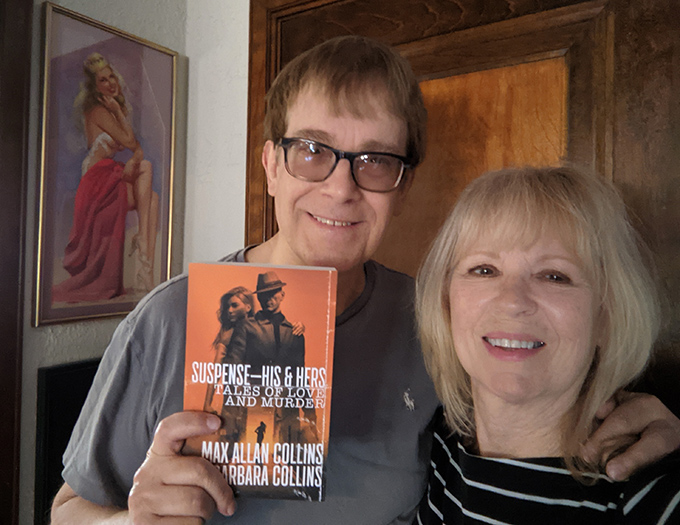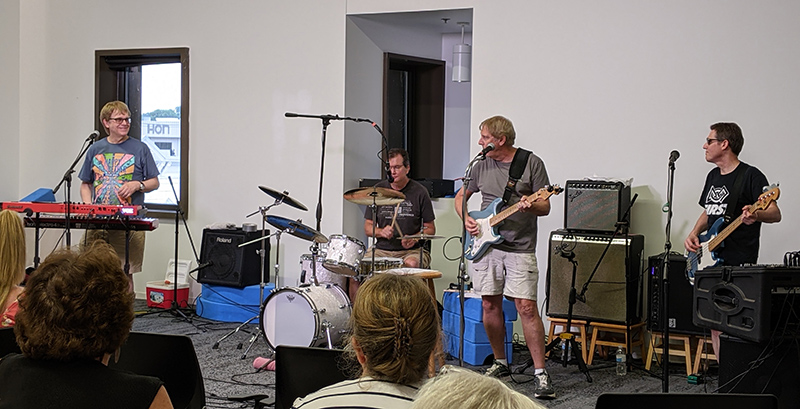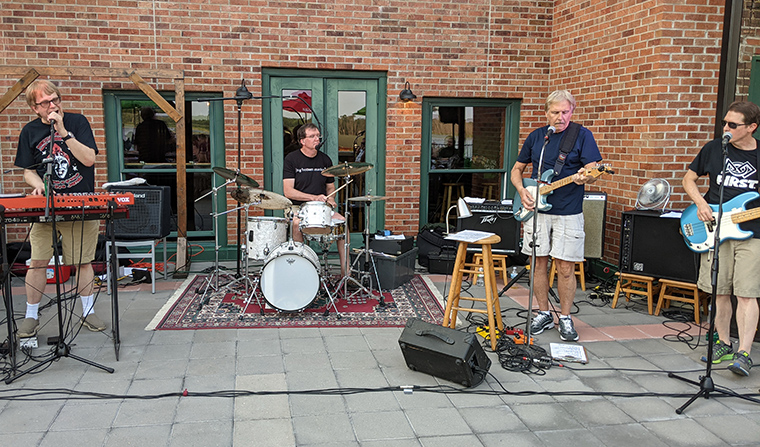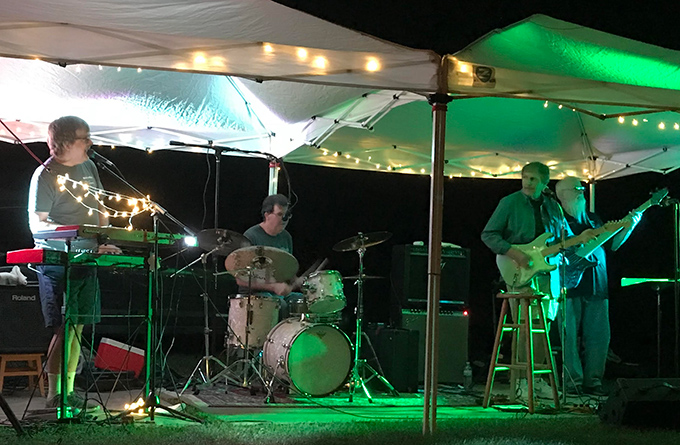Suspense – His and Hers (subtitled Tales of Love and Murder) is available now, both in Kindle e-book and a handsome trade paperback. It collects stories by Barb and me both individually and together. Two Quarry short stories are included (“Guest Service” and “Quarry’s Luck”) and a rare Ms. Tree short story (the Edgar-nominated “Louise”). It’s a pleasantly plump collection (almost 300 pages) and I think you’ll like it. Wolfpack did a marvelous job on the cover.
Speaking of marvelous covers, feast you eyes on Fay Dalton’s cover for Fancy Anders Goes to War, which is available now for pre-order at $2.99 in Kindle form. There will be a trade paperback edition as well, but that isn’t up for pre-order just yet. This is the first of three novellas I’ve done for NeoText about Fancy, who is a 24-year-old (obviously) female detective in Los Angeles during World War II. The subtitle is Who Killed Rosie the Riveter? The fantastic Ms. Dalton has, in addition to the cover, provided a full-page illustration for each of the ten chapters.
If you like to read on Kindle, an advantage is that Fay’s artwork is presented in color (well, a couple were intentionally left black-and-white for film noir reasons) whereas only the cover art will be in color in the trade paperback. These are short novels (hence the term novella) but longish ones, running 30,000 words each. They will make nice additions to the shelves of Luddites like me who prefer “real” books.
It is my intention, my hope, that the three Fancy Anders novellas will be collected in one book with the Fay Dalton art properly showcased. (The Fancy Anders trade paperbacks are POD and only the cover will be in color.) I had a wonderful time doing these stories and hope more of Fancy’s cases will find their way through my fingers to the pages of books. These may not be as hardboiled as Quarry or Nolan or Hammer, but then what is? Fancy is like a younger Ms. Tree and is not shy about taking bad people down violently.
My classic rock band Crusin’ will be performing at the Muscatine Art Center’s Ice Cream Social this coming Sunday. Details here.
Right now this is the final scheduled gig of our short season. I had hoped to line up a few more, but with the surge in Covid the better part of valor for Crusin’ is to fade into rehearsals for our much-postponed CD of original material. Rehearsing and recording that CD is our winter project. It was supposed to be last winter’s project, but….
Here is a link to a video of the second set of our recent Sunday Concert series performance. I warn you that the instrumental is waaaaay back – you can barely hear the keyboards and the punch of the guitar is dialed down from the actual event. That’s because this is a sound board recording and you get mostly vocals.
I’m providing this because I do think it captures the casual intimacy of the event, which is quite different from working a larger venue. Thanks to Chad Yocum for shooting the video and providing the link.
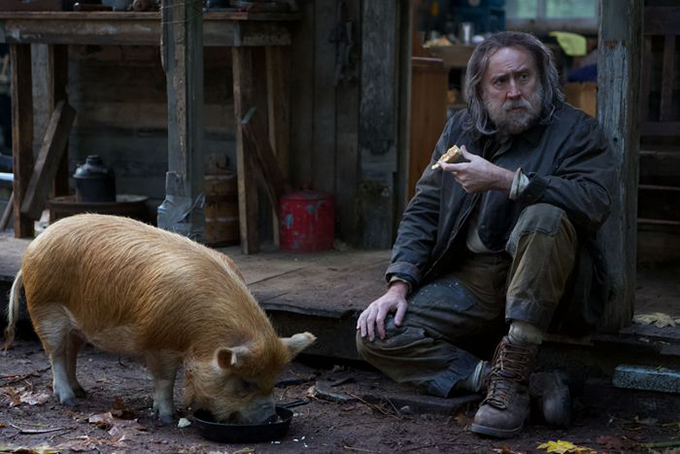
As I may have mentioned, my son Nate and I are fans of actor Nicolas Cage. It’s odd to be a Nic Cage fan, because you never know whether the film at hand will be gold or dross, or something in between.
Some time ago Cage began taking (apparently) any job that comes his way if his price is met, and that price must not be sky high considering how many jobs he takes. This practice began some years ago when he had a tax problem that sent him spiraling from A-list to Direct-to-Video.
Cage was always quirky and for some an acquired taste. But here’s the thing: Nic always gives 100%. The film can be utter shit (and occasionally is – a few have caused even the loyal Collins boys to bail) but you never know when something really special is going to crop up.
Willy’s Wonderland, with the sublime premise of a defunct Chucky Cheese wanna-be restaurant becoming a haunted house for its mechanical animal musicians, has Cage giving a full-bore eccentric performance that almost elevates it to something special. Not quite, but for some of us, essential viewing. Primal is terrible, A Score to Settle rather good. You never know. A Cage movie is the surprise package of cinema.
Now and then, however, Nic and his collaborators knock it out of the park. Often he does extreme action and/or horror stuff – common among low-budget indies – and Mandy is something of a masterpiece. It’s sort of The Evil Dead without the laughs (except very dark ones) or the zombies. I would recommend it wholeheartedly to any even mildly adventurous movie fan.
But the current Pig (streaming for a price at the moment) is a reminder of just how great an actor Cage can be when a director handles him well and the material is strong. On the surface, it seems to be a revenge story, but that’s an assumption you’ll make that will prove wrong. It has tension and one violent scene, but it’s not an action movie. The premise sounds fried even for Cage: a hermit in the forest survives on the truffles he and his truffle pig find, which are sold to a city-boy hustler regularly; somebody beats Cage up, steals the pig, and Nic goes to the big city (Portland) to get his pig back.
If this sounds like you asked somebody to imagine a movie that even Nic Cage would reject, you’d be very, very wrong. It’s a wonderful movie and about all sorts of things, but revenge isn’t really one of them. Unexpectedly it becomes about being a chef, as opposed to a hermit, but really it explores loss and father-son dynamics. Pig centers on (get ready for it) an understated Cage performance that is Oscar worthy, and includes one of the best scenes you’ll ever see in any movie – what is that scene about? The hermit makes a chef cry in the latter’s trendy restaurant.
You can dismiss me as a crazy hermit who lives in Iowa if you like, but the loss will be yours.
Here is a delightful review of Antiques Carry On from Ron Fortier’s Pulp Fiction Reviews. But…it isn’t written by Ron! Suspense killing you? Read on…
ANTIQUES CARRY ON
A Trash ‘N’ Treasures Mystery
By Barbara Allan
Severn House
Guest Reviewer -Valerie Fortier
Ron isn’t into Cozy mysteries and when this one arrived in the mail, he dropped it on my desk top with the suggestion I give it a go. Months later it’s still sitting there and I decided to give it a try. As a Mom myself, I totally get the mother-daughter dynamics. Sometimes they gel, other times they are nothing but oil and water.
I would recommend you take time to meet Vivian and Brandy. The mother-daughter team that never misses a chance to inject humor and fun while investigating a new mystery. I really enjoyed the book; especially the great twist at the end in regards to who done it. Just when you think you’ve got it solved, there’s more to be revealed.
The book offers up a truly wonderful cast of characters to “cozy” up by the fire and share some time with.
Final note – This is the start and end of my reviewing career. Thanks, Ron.
Finally, here is an interesting, in-depth look at the film of Road to Perdition.
M.A.C.
